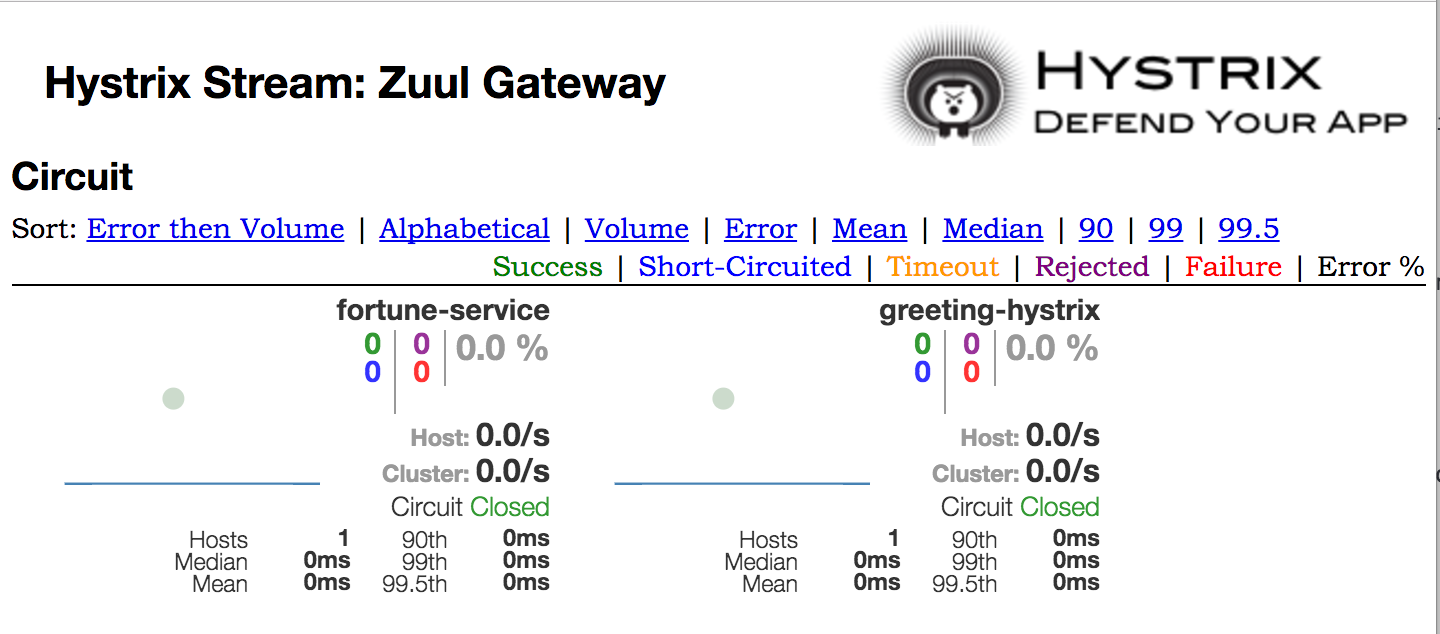1. Start up "all the things"
Let’s begin by launching these services:
-
config-server -
service-registry -
two instances of
fortune-service(configure the SERVER_PORT for the second fortune-service to 8788)
Ensure that the Eureka Dashboard displays two registered instances of fortune-service.
2. Create a Zuul-embedded Spring Boot App
-
Visit the spring boot initializr, and create yourself a spring boot app with the following dependencies:
-
Zuul
-
Eureka Discovery
-
Config Client
You don’t have to explicitly add spring-boot-starter-web, or the actuator. These are already included via Zuul transitive dependencies.
-
-
Set the groupId to
io.pivotal -
Name the artifact
zuul-gateway -
Click Generate Project
Unpack the zip file alongside all of your other projects, in the spring-cloud-services-labs folder.
3. Configure the Zuul Gateway
-
Create a
bootstrap.ymlfile, set the spring application name tozuul-gateway -
Create an
application.ymlfile, set the server port to 8200 -
Edit the
ZuulGatewayApplication, and add the following annotations:@EnableDiscoveryClient, and@EnableZuulProxy
4. Zuul Leverages other Spring Cloud Services
Zuul is designed to work in concert with other Spring Cloud Netflix services.
Out of the box, Zuul:
-
creates routes for each service it sees in Eureka
-
uses Ribbon to load balance across all app instances for a service
-
wraps these network calls in a circuit breaker using Hystrix
Let’s verify this.
-
Start your Zuul application
-
Visit the
zuul-gatewayactuator/mappingsendpoint and note that it exposes a route forfortune-service/. You can now access the fortune service indirectly via the zuul gateway endpoint. By default, for an app named x, the endpoints matching the pattern /x/** are forwarded to that app -
Visit the
zuul-gatewayfortune-service/endpoint multiple times. Verify that the calls are load balanced across the two instances in a round-robin fashion. -
Visit the
zuul-gatewayhystrix.stream endpoint and verify that it’s generating circuit breaker metrics. -
Launch the
hystrix-dashboard, visit its main page, and enter the above stream url. Click Monitor Stream. You should see that the zuul gateway has a circuit breaker around calls to the fortune-service. -
Launch the
greeting-hystrixapplication. Wait until this app registers with Eureka. Within perhaps a minute, the zuul gateway will pick up on this and dynamically add a new route to proxy calls to that application too. -
In a browser, visit the new zuul greeting-hystrix route
-
In the hystrix dashboard, you should now see two circuit breakers (as shown below).

5. Write a ZuulFilter
Zuul’s design is similar in design to servlet filters. Zuul filters can route requests based on different conditions.
In fact, the behavior we just witnessed, of proxying or forwarding routes to backing services based on services registered in a eureka registry, is all implemented as a set of Zuul Filters.
In your IDE, drill down from your main class file to the @EnableZuulProxy annotation definition. You’ll see that this annotation imports a ZuulProxyConfiguration class, which configures a number of Zuul filters and other spring beans, including a RibbonRoutingFilter and a DiscoveryClientRouteLocator.
Netflix uses Zuul to dynamically influence the routing of requests, often to run tests in production environments. For a given service, they may have a special cluster that’s configured in debug mode, and they’ll use Zuul to route requests from specific (perhaps problematic) devices to that cluster. Let’s write a Zuul Filter that does something along these lines.
-
Stop the zuul-gateway app
-
Stop your second instance of fortune-service (the one running on port 8788).
-
Restart that second instance of fortune-service, but this time have the service register itself under a different name (also known as service id):
fortune-debug. This instance will represent our debug cluster.SERVER_PORT=8788 SPRING_APPLICATION_NAME=fortune-debug mvn spring-boot:run -
Check once more that our Eureka dashboard is properly reflecting our current state: that we have two separate applications registered, one under the name of fortune-service, and the other under the name of fortune-debug
The goal is to write a Zuul Filter that looks for a ?debug=true query parameter in a request to fortune-service and, instead of routing those requests to the fortune-service, it should instead route them to the fortune-debug instance.
Name your zuul filter class FortuneDebugRouteFilter and make sure it extends the ZuulFilter abstract base class.
Once your filter is written, it will have to be registered as a spring bean in your spring application context, as follows:
package io.pivotal;
import org.springframework.boot.SpringApplication;
import org.springframework.boot.autoconfigure.SpringBootApplication;
import org.springframework.cloud.client.discovery.EnableDiscoveryClient;
import org.springframework.cloud.netflix.zuul.EnableZuulProxy;
import org.springframework.context.annotation.Bean;
@SpringBootApplication
@EnableZuulProxy
@EnableDiscoveryClient
public class ZuulGatewayApplication {
public static void main(String[] args) {
SpringApplication.run(ZuulGatewayApplication.class, args);
}
@Bean
public FortuneDebugRouteFilter fortuneDebugRouteFilter() {
return new FortuneDebugRouteFilter();
}
}One way to implement this filter is as a "pre" filter, that substitutes the service id "fortune-service" with "fortune-debug" under the right conditions. Here’s the implementation:
package io.pivotal;
import com.netflix.zuul.ZuulFilter;
import com.netflix.zuul.context.RequestContext;
import static org.springframework.cloud.netflix.zuul.filters.support.FilterConstants.*;
public class FortuneDebugRouteFilter extends ZuulFilter {
@Override
public String filterType() {
return PRE_TYPE;
}
@Override
public int filterOrder() {
return PRE_DECORATION_FILTER_ORDER + 1;
}
@Override
public boolean shouldFilter() {
RequestContext ctx = RequestContext.getCurrentContext();
String serviceId = (String) ctx.get(SERVICE_ID_KEY);
return ctx.debugRequest() && "fortune-service".equalsIgnoreCase(serviceId);
}
@Override
public Object run() {
RequestContext ctx = RequestContext.getCurrentContext();
ctx.set(SERVICE_ID_KEY, "fortune-debug");
return null;
}
}5.1. The coup de grâce
-
Start your
zuul-gatewayapplication once more -
Monitor the console output for both
fortune-serviceandfortune-debug(make sure your log level is set to DEBUG) -
Visit the zuul application’s fortune service endpoint. You should be able to verify that the fortune-service application instance receives the request
-
Now tack on a "?debug=true" request parameter to your http query. This time, the request should get routed to your
fortune-debuginstance.
Congratulations! You’ve completed this lab.
To learn more about how Netflix uses Zuul, here’s a great presentation given at the Spring One Platform conference in 2016 by Mikey Cohen titled Netflix’s Edge Gateway Using Zuul.